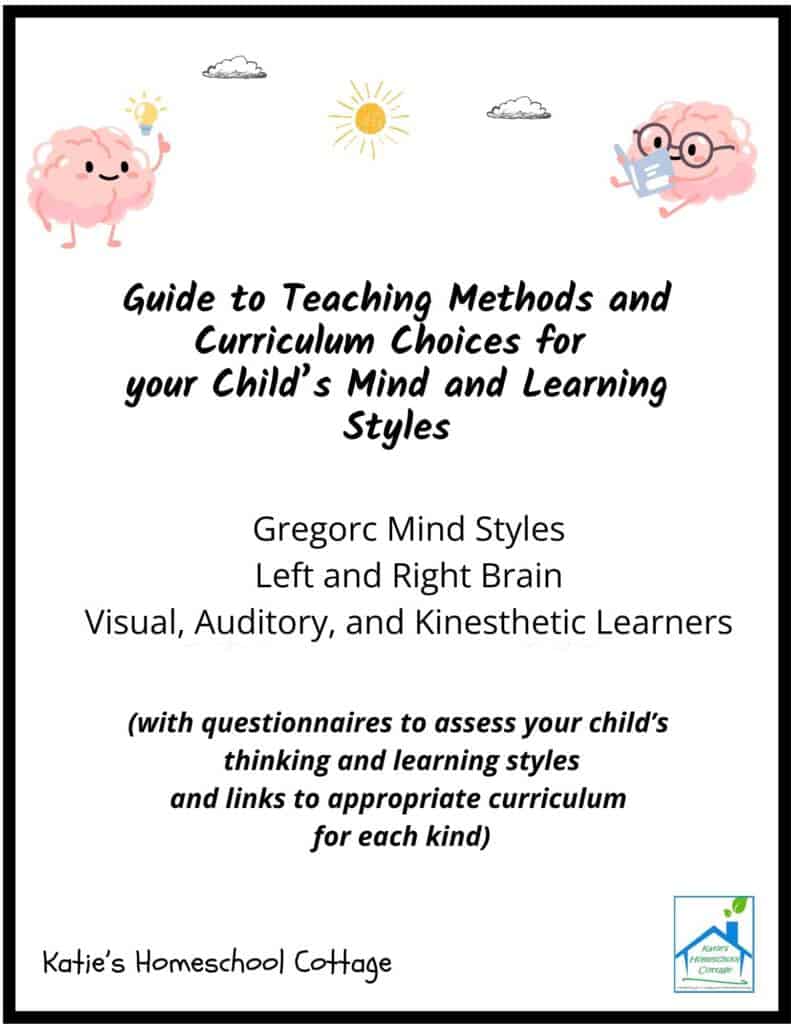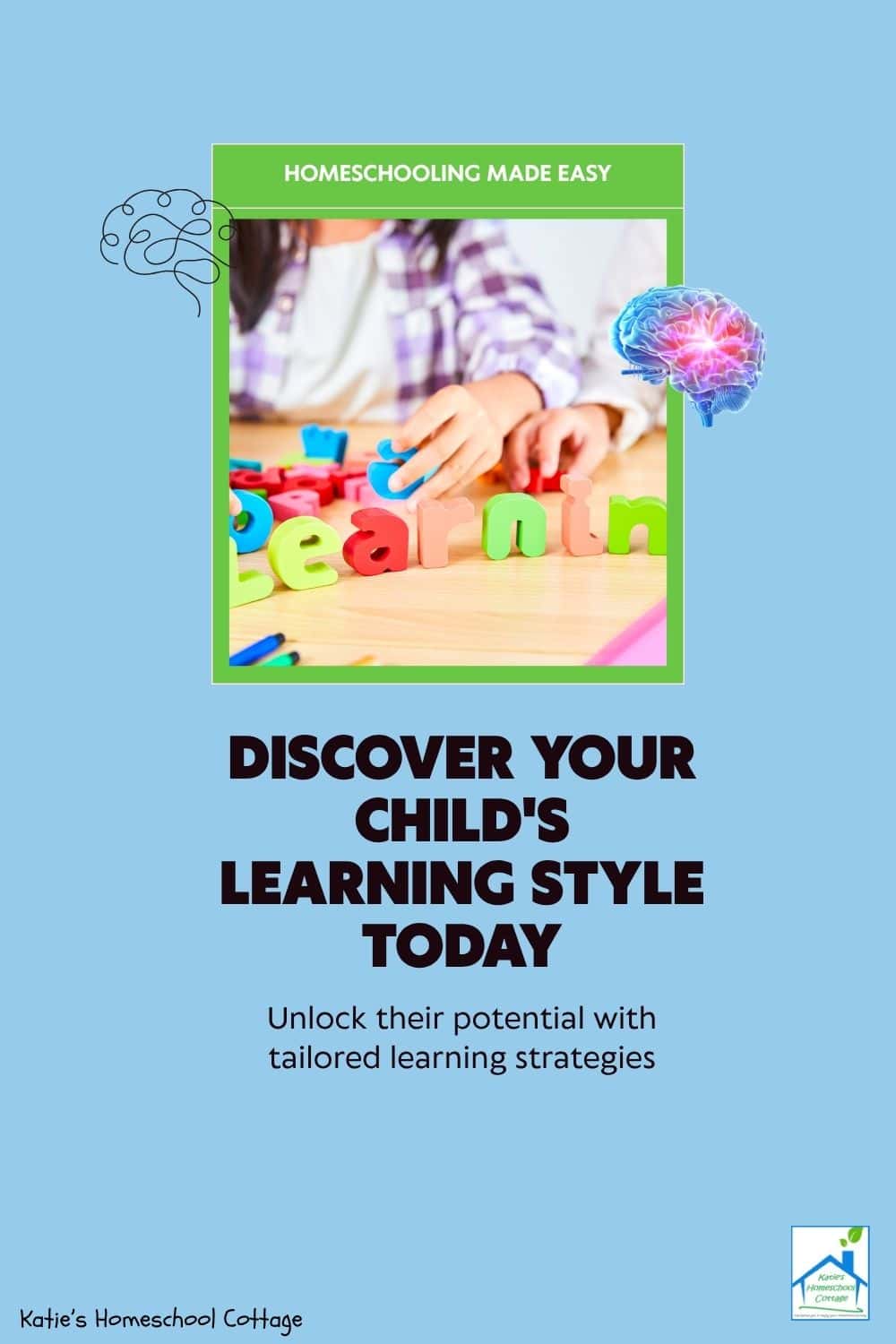As a homeschool parent, how can you discover your child’s learning style when we often focus on finding the “perfect” curriculum or the “best” method? One of the most powerful tools you can use to support your child’s learning is understanding how they learn best.
Learning isn’t one-size-fits-all—and when you discover your child’s unique learning style, everything changes.
Lessons become more engaging; struggles begin to ease; and, your child’s confidence can soar.
In this post, we’ll explore the different types of learning styles, including Gregorc Mind Styles, left- and right-brain learning preferences, and the well-known visual, auditory, and kinesthetic learning styles.
You’ll also learn how to use this knowledge to choose teaching methods, materials, and curriculum that meet your child’s needs and help them thrive in your homeschool.
What is a Learning Style—and Why Do They Matter?
A learning style refers to the natural way a person processes information and experiences the world.
Some children grasp concepts quickly when they see them in pictures; others remember things best by hearing them; and still others need to move, touch, or manipulate to truly understand.
Recognizing your child’s learning style isn’t about labeling them—it’s about unlocking how they absorb and apply knowledge most effectively.
When you match your teaching approach to your child’s style, you’re not just making school more enjoyable—you’re laying a foundation for long-term academic success, self-awareness, and independent learning.
You’ll also reduce frustration, improve focus, and encourage a lifelong love of learning.

To assist you in determining your child’s best learning methods and curriculum, this free ebook will help you with descriptions of each of the learning styles. For assessments to determine your child’s learning and thinking style and links to the curriculum that best meets their needs you will want the guide mentioned below.
The Gregorc Mind Styles: A Deeper Look at Thinking Patterns
Dr. Anthony Gregorc developed a model of learning based on how people perceive and organize information. The Gregorc Mind Styles Model breaks learners into four categories based on two key dimensions:
- Perception: Concrete (based on direct experience) vs. Abstract (based on ideas and theories) (How the child perceives or takes in the information best)
- Ordering: Sequential (step-by-step) vs. Random (nonlinear and intuitive) (How the child organizes and assimilates that information best)
These combine to create four mind styles:
1. Concrete Sequential (CS)
- Prefers structure, step-by-step instructions, and clear directions.
- Learns best through repetition, schedules, and hands-on tasks with predictable outcomes.
- Benefits from workbooks, traditional curriculum, checklists, and planners.
2. Abstract Sequential (AS)
- Logical, analytical, and thrives on theories, facts, and structured intellectual discussion.
- Enjoys reading, lectures, and independent research.
- Benefits from classical education materials, textbooks, and discussion-based learning.
3. Abstract Random (AR)
- Emotional, people-oriented, and sensitive to tone and atmosphere.
- Learns through stories, group discussions, art, and real-life connections.
- Benefits from unit studies, literature-rich programs, and creative expression.
4. Concrete Random (CR)
- Intuitive and experimental. Loves freedom, discovery, and problem-solving.
- Learns through trial and error and prefers flexibility and independence.
- Benefits from project-based learning, entrepreneurship units, and open-ended curriculum.
Understanding your child’s Gregorc style helps you choose curriculum that complements their cognitive strengths.
For example, a Concrete Sequential learner might thrive with a program like Abeka or Rod & Staff, while a Concrete Random learner may love unschooling, unit studies, or STEM kits.
Left-Brained and Right-Brained Learning Style
The idea of left-brain vs. right-brain learners comes from research on how each hemisphere of the brain processes information. While everyone uses both sides of their brain, most people show a preference for one side in their thinking and learning patterns.
Left-Brained Learners
- Prefer logic, order, language, and analysis.
- Tend to enjoy math, grammar, reading, and organized routines.
- Do well with linear, structured teaching methods and clear objectives.
- Thrive on written instructions, outlines, and independent study.
Right-Brained Learners
- Prefer creativity, images, music, and intuition.
- Excel in storytelling, art, drama, and hands-on exploration.
- Learn best through visuals, metaphors, and seeing the big picture.
- Often dislike rote memorization or traditional textbook learning.
In homeschooling, knowing if your child leans left- or right-brained helps you balance their strengths.
A right-brained learner may flourish with visual-rich curriculums like Moving Beyond the Page or Waldorf-inspired approaches, while a left-brained learner might enjoy Saxon Math, Well-Trained Mind classical plans, or video lectures.
The VAK Model: Visual, Auditory, and Kinesthetic Learners
The VAK learning style model is one of the most popular and easy-to-use frameworks for identifying how students take in information.
1. Visual Learners
- Think in pictures and remember what they see.
- Benefit from charts, diagrams, mind maps, color-coded notes, and videos.
- Prefer written instructions and visual organization.
Teaching Tips:
- Use whiteboards, graphic organizers, flashcards, timelines, and drawing.
- Choose curriculum with strong visual elements (like Notgrass History or Apologia Science with colorful notebooks).
2. Auditory Learners
- Learn through listening and speaking.
- Remember spoken directions and enjoy discussions, songs, and read-alouds.
- Often talk through problems or repeat facts aloud to remember them.
Teaching Tips:
- Include audiobooks, oral narration, memory songs, and group discussions.
- Try curriculum like Story of the World (audiobook versions) or Sing Spell Read and Write.
3. Kinesthetic Learners
- Learn by doing, moving, and physically engaging with material.
- Struggle with sitting still for long periods or purely textbook learning.
- Thrive with hands-on activities, real-world projects, and role-play.
Teaching Tips:
- Look for curriculum like Friendly Chemistry, Handwriting Without Tears, or Montessori-based resources.
- Incorporate manipulatives, nature walks, experiments, and crafts.
How to Identify Your Child’s Learning Style
Your child’s learning style often overlaps with others and many children benefit from a mix of strategies.
That said, you can usually spot strong preferences through:
- Observation during lessons
- Asking how they prefer to learn
- Using online or printable assessments
- Reflecting on which subjects are a struggle and which are fun
Here are a few clues:
Do they love freedom, try new things without instructions, or invent games? Concrete Random.
Does your child doodle or color-code notes? Likely a visual learner.
Do they hum, repeat facts aloud, or love read-alouds? Probably auditory.
Do they fidget, build with blocks, or struggle to sit still? Likely kinesthetic.
Do they crave structure and clarity? Concrete Sequential.
Are they always asking “why” and love complex discussions? Abstract Sequential.
Are they expressive, emotional, or drawn to storytelling? Abstract Random.
This guide has assessments and questionnaires to assist you in determining your child’s learning style and suggests teaching methods, materials, and curriculum to best meet your child’s needs.

Matching Teaching Style to Learning Style
Once you have a better sense of how your child learns, you can begin to intentionally shape your homeschooling to meet those needs. Here are a few ways to do that:
Teaching Methods
Kinesthetic: Include movement breaks, science kits, building projects, and crafts.
Structured and Sequential: Use checklists, daily planners, and lesson plans.
Creative and Open-Ended: Try unit studies, nature journaling, or child-led projects.
Interactive and Hands-On: Use manipulatives, simulations, role-play, or field trips.
Visual: Add charts, color-coded notebooks, maps, and videos.
Auditory: Use storytelling, discussion, and audio resources.
The Benefits of Teaching to Your Child’s Learning Style
Adapting your homeschool to match your child’s learning style isn’t about creating a rigid system—it’s about building a flexible, responsive, and empowering approach to education.
Here are some of the biggest benefits:
- Improved comprehension and retention: Children understand and remember more when it’s taught in a way they naturally process.
- Increased motivation and joy: Learning feels less like work and more like discovery.
- Reduced frustration and burnout: Less resistance, fewer tears, and smoother days.
- Stronger parent-child relationship: Less conflict and more collaboration.
- Greater independence and confidence: When kids feel successful, they’re more likely to take initiative in their learning.
Final Thoughts
Every child is wonderfully unique—and one of the greatest gifts of homeschooling is the freedom to teach in a way that honors their individuality.
By taking time to understand your child’s learning style—whether through Gregorc’s mind styles, brain dominance, or the VAK model—you’re not only making homeschooling more effective, but more joyful and meaningful.
So go ahead—observe, explore, assess, and adjust.
Your child’s learning style is a key to unlocking their potential, and your homeschool can be the place where they truly thrive.





